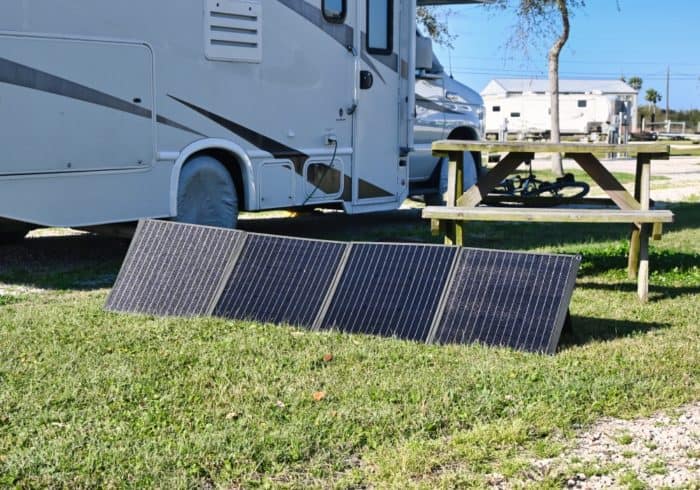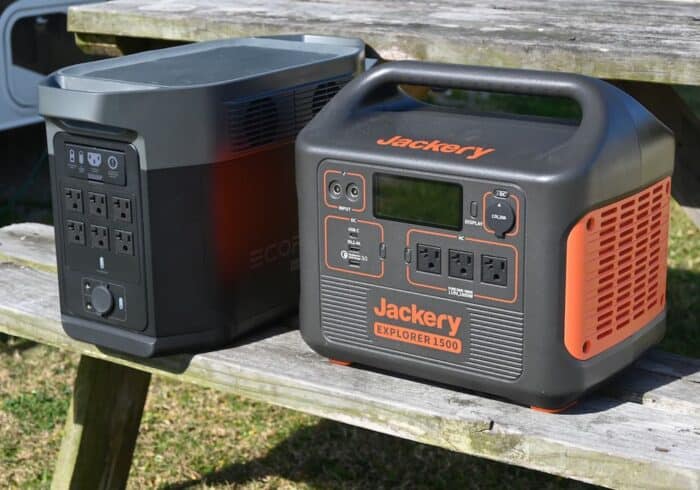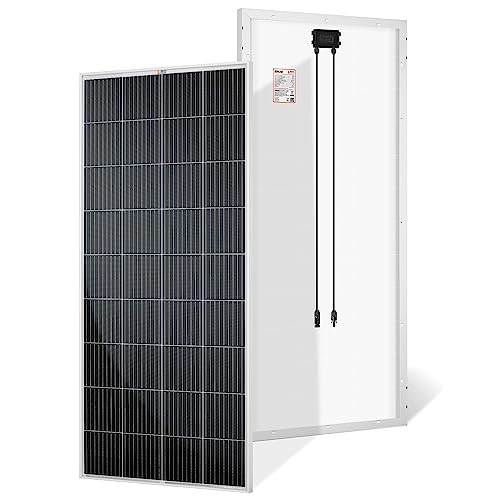Goal Zero Yeti 1500X Vs 3000X Power Station Differences
The popular power station/solar generator company from Utah, Goal Zero, recently released its latest lithium power stations.
Two of the new models are the Yeti 1500X (click to view on Amazon) and the Yeti 3000X (click to view on Amazon).
They’ve implemented a couple of features that I have been asking for for a couple of years now, and they’re now competing with some of the best power stations on the market.
Related Product: Charge Your Yeti 1500X/3000X Much Faster With The 600W Power Supply (Click to view on Amazon)
In this post, I am going to compare the Yeti 1500X and the 3000X. What makes them different, why it matters, and how to decide between the two.
In addition to comparing the two, I’m also going to show you how to connect third-party solar panels, how to connect your RV/trailer/camper to a Yeti X power station, and share some of the best alternative power stations.
Let’s start by comparing the specifications. There are not a lot of differences, but a table makes it easier to see.
Yeti 1500X Vs 3000X – Specifications Compared
Last update on 2024-04-24 / Affiliate links / Images from Amazon Product Advertising API
A Closer Look At The Differences
Battery Capacity
As the names imply, the Yeti 3000X has exactly double the battery capacity. 1516 watt-hours versus 3032 watt-hours.
Both are larger than the older Yeti 1400 which had 1425Wh.
Design
The Yeti 3000X is slightly taller to fit more batteries. Other than that, they’re the same.
What’s In The Box
Goal Zero includes a faster wall charger (230W) with the Yeti 3000X, which is why both can be charged in 14 hours with the included charger.
The one included with the 1500X is a 120W charger.
Both of them support the faster 600W charger (click to view on Amazon) that can charge the 1500X in 3 hours and the 3000X in 6 hours.
A rolling cart is also in the box of the Yeti 3000X but not the Yeti 1500X.
With its telescoping handle and heavy-duty wheels, you’re going to have a much easier time moving the power station around.
Size & Weight
The 3000X is almost 53% heavier at 69.78 pounds compared to the 45.64 pound Yeti 1500X.
Yeti 3000X is a little over three inches taller.
What They Have In Common
Inverter
Both use the same 2000W pure sine wave inverter with a 3500W surge.
The surge watts can be used for a short amount of time to power more power-hungry tools and appliances.
You should never rely on those watts to power anything though.
Charge Controller
Both use the same MPPT charge controller that can handle a total of 600 watts of solar input.
You can also use a USB C PD wall charger (click to view on Amazon) for another 60W of input.
To reach the 600W solar input limit, I recommend connecting four Boulder 200W solar panels (click to view on Amazon) with a Goal Zero High Power Port combiner (click to view on Amazon).
You can also connect eight 100W panels in a series-parallel connection.
Ports, Screen & Buttons
You’ll find exactly the same ports on both Yetis.
Two AC outlets, two USB A, one USB C PD, one USB C, a full-size regulated 12V output, two 12V 6mm outputs, one HPP output, and two inputs (8mm & Anderson Powerpole).
One of the USB C ports is a PD port, which means that it’s both an input and an output, and can be used to charge the Yeti battery if you have a USB C PD wall charger (click to view on Amazon).
The screen shows input/output watts, output amps, watt-hours used, battery percentage, battery bars, time to full/empty, and battery voltage.
Three buttons control what unit you’ll see on the screen, whether to show battery percentage or time to empty/full and the backlight of the screen.
There are also buttons above each output type (AC, USB, 12V) to turn on or off the different types.
WiFi
With the built-in wifi capabilities, you can control and monitor the Yeti from your mobile phone.
Turn on/off ports, monitor the battery percentage and the input/output, and control how fast and far you want to charge the battery to extend its life.
The Yeti connects to your home WiFi, it doesn’t create its own network.
Expansion Module Slot
The expansion module slot is used for the optional MPPT charge controller (click to view on Amazon), which allows you to connect another 360W of solar to your Yeti.
Later on, you’re supposed to be able to use the Yeti Link expansion module as well, but it’s not supported as of December 2020.
Can’t Use Wall Charger & Solar At The Same Time
For some reason, the latest Yeti X power stations can’t handle both solar and a wall charger at the same time.
You also can’t use both the 8mm and the Anderson Powerpole at the same time.
The port that receives the highest voltage will be the active one.
Conclusion
What it comes down to is how much battery capacity you need.
The Yeti 3000X comes with a faster wall charger and a rolling cart, but it’s not that much bigger in terms of size, although heavier.
Are you going to be able to recharge the battery daily with solar or a wall charger, and how much electricity do you need to use between charges?
If you’re buying a power station to use in case of emergencies because you live in an area with regular power outages, and want to be able to power not only laptops, phones, and tablets, but also a microwave, fans, and a small space heater, the Yeti 3000X (click to view on Amazon) is going to be the better option because you’ll have twice the battery capacity.
I still recommend having at least one Boulder 200 solar panel (click to view on Amazon), so you can charge the battery when it’s sunny.
But to give you an example, a 3032 watt-hour battery will run a microwave for over two hours, or a 50 inch TV for about 20 hours.
If you’re a traveler though and have a couple of solar panels on top of an RV or van that will recharge your battery, and you only need to charge a phone, tablet, and laptop, the Yeti 1500X (click to view on Amazon) will be good enough so long as you get sunshine at least once a week.

Solar Panel Recommendations
While Goal Zero makes its own solar panels, you can use almost any panel to recharge the batteries as long as you have the right adapters.
Always make sure that your panels are rated below 50V, or that the total voltage is below 50V if you combine several panels in series.
Last update on 2024-04-24 / Affiliate links / Images from Amazon Product Advertising API
The Required Additional Adapter
Some of the panels in the table above require an adapter. Since there are two types of input ports, you have two options.
You can use an MC4 to Anderson Powerpole (or what Goal Zero calls High Power Port), and this is the adapter (click to view on Amazon) you need to do that with.
Note that the orientation of the connectors on this adapter is not the same as on Goal Zero, so you’re going to have to rearrange them, which is easy to do.
Simply slide down the sleeve, slide off the connectors off of each other, turn them so they fit the Yeti, then slide them on, and finish by sliding up the protective sleeve.
If you would rather use the 8mm port, this is the adapter (click to view on Amazon) you will need.
This does not require any rearranging, but since the 8mm port can only handle 120W of input if you have more than 150W of solar, I recommend using the Anderson Powerpole.
You can’t use both input ports at the same time, and the Yeti will only allow a charge from the port that is receiving the highest voltage.
Combine Several Panels
(click links to view products on Amazon)
You can combine several panels if they have Anderson, 8mm, or MC4 connectors.
Before connecting any panels, you need to make sure that the wiring can handle the total amperage that your panels will be outputting.
For panels with the Anderson Powerpole (High Power Port) connector, use the Goal Zero High Power Port Combiner Cable.
This can take up to four panels, so you could connect four Boulder 200 panels.
For panels with the 8mm connector, use the Goal Zero 8mm Combiner Cable.
This has four 8mm female plugs, and will plug into the High Power Port input on the Yeti. You can connect up to four Boulder 100 panels.
For panels with MC4 connectors, you need an MC4 Y branch to do so.
Here is an MC4 Y branch for two panels, here is one for three panels, and here is one for four panels
All of the above methods will connect the panels in parallel, which means that the amperage will increase but not the voltage.
With the latest Yeti X power stations, you can also connect panels in series, which will increase the voltage but not the amperage.
You can’t connect the Boulder panels in series unless you cut some cables.
If the panels have MC4 connectors, you can possibly connect up to two 12V panels in series by connecting the positive MC4 connector from the first panel to the negative MC4 connector on the second panel.
To know whether or not you’re below the 50V limit, check the VMP ratings of the panels and add them together. You should never exceed the voltage limit.
Extension Cables
Here are the extension cables I recommend for different setups.
MC4
Windynation MC4 Extension cables. These come in different lengths and gauges. When combining several panels, make sure that the wire can handle the total amperage of your panel(s).
Anderson Powerpole (High Power Port)
Goal Zero High Power Power 30ft extension cable. Made by Goal Zero, so it will fit the Boulder 200 panels and High Power port adapters.
8mm
Goal Zero 30ft 8mm extension cable. Made by Goal Zero, so it will fit the boulder 100 panels and 8mm adapters. Since this is a 16 gauge cable, I wouldn’t use this for any panel(s) outputting more than 10 amps.
How To Connect A Yeti Power Station To Your RV/Trailer/Camper
Even though the Yeti X power stations don’t have a 30A or 50A plug, you can use adapters to connect your RV directly to the inverter.
The adapter will not increase what the inverter is capable of, and you’re still only going to get 2,000 watts at most out of the Yeti.
But 2,000 watts is powerful enough to at least run a microwave, or the water heater, in addition to powering the outlets in your camper to run and charge your everyday devices.
If you have a 30A RV, this is the adapter you need.
If you have a 50A RV, this is the adapter you need.
You’re not going to be able to run the RV AC. It might be possible to run a 13,500BTU AC if you’ve installed a Microair EasyStart on your RV AC, but I haven’t done it myself so I can’t guarantee anything.
If you manage to get it to run, it will quickly drain the battery within an hour or two depending on which Yeti you own.

Best Alternatives To Yeti X Power Stations/Solar Generators
Here are three good alternatives to the Yeti X batteries.
1002Wh battery capacity, MPPT, three AC outlets, USB C, regulated 12V output, two input options (same as Goal Zero), and portable.
Not as powerful since it only has a 1000W inverter, but if you don’t need more, why not buy two of these instead of one large Yeti?
Ecoflow Delta + 110W Solar Panel
1260Wh battery capacity, MPPT, six AC outlets, USB C, regulated 12V output, quickly recharge (0 to 80% in 1 hour).
1800W inverter with a 3300W surge. Includes a 110W solar panel. Great option and one of my favorite power stations on the market right now.
2400Wh battery capacity, MPPT, two AC outlets, USB C, regulated 12V. 1000W inverter with 1200W surge.
Can handle panels up to 68V VOC. A great option if battery capacity is more important than a powerful inverter. Portable design, and a popular power station.
Please let me know if you have other great alternatives.
Frequently Asked Questions
Can You Use A Goal Zero Yeti X Power Station While It’s Charging?
Yes. It doesn’t support true pass-through charging, but a charger or a solar panel can be charging the batteries while you’re draining them by using any of the outputs.
Can You Recharge A Yeti X With A Gas Generator?
Yes, as long as your gas generator has a 15A outlet, you can plug in the Yeti X wall charger.
How Can You Plug In 800W Of Solar (Boulder 200 x 4) When The Max Input Is 600W?
Because a 100W panel doesn’t actually generate exactly 100W, you can connect more than 600W worth of solar panels.
The MPPT charge controller will not accept more than a total of 600W input, so if it’s receiving 650W, it will limit it to 600W.
When the sun is weak, your 800W solar panels might only generate 200 or 300 watts, which is a great reason to have a lot of solar if you need a lot of electricity throughout the day.
Can You Replace The Batteries In A Yeti X?
Not currently (as of December 2020).
Can You Combine Two Yeti X For Twice The Power?
Nope.
How Do I Charge A Yeti With A USB C PD Charger?
You need a wall adapter that can output at least 60W. Like this one from EHO.
Then you just need a powerful enough USB C cable, like this one from Anker.
How Do I Make The Lithium Battery Last Longer?
The Yeti batteries are rated at 500 cycles to 80% capacity. That means that when you’ve used the Yeti from 100 to 0%, 500 times, the total battery capacity will be at 80%.
You can do a couple of things to increase the number of cycles you’ll get out of the battery before it loses that much of its total capacity.
Please note that this information is based on what I have read and is not official information from Goal Zero.
- Try to keep the battery above 20% at all times and below 80% – Lithium likes to stay neither fully charged or emptied. If you’re going to leave your battery for months, keep it fully charged and connected to the charger, but if you’re using it every day and can keep it between 20-80%, do so.
- Do shallow discharges – In addition to keeping it between 20 and 80 percent, try to do partial-discharge cycles, meaning that if you start using the battery at 80 percent, stop at 60 percent and recharge it to 80 percent before using it again, and so on.
- Never use the battery in freezing temperatures – Lithium can be discharged in below-freezing temperatures, but charging a lithium battery in freezing temperatures is a no-no! To be safe, I don’t recommend using the battery at all in freezing temperatures.
- Charge it as slowly as possible – It might seem great to be able to charge your Yeti within a couple of hours with a fast wall charger or a lot of solar panels, but it actually reduces cycle life since it puts a lot of stress on the batteries. If possible, charge the Yeti as slowly as possible, and use the Yeti phone app to control how fast it charges.
What About The Yeti 6000X?
The Yeti 6000X has a 6071Wh battery capacity, comes with a rolling cart, and a 600W wall charger.
Other than that, it’s identical to the 1500X and 3000X except for its size and weight.
If you have any questions or something to add, please leave a comment down below.










Quick question. I have a Yeti 3000X and 3 Renogy 200w eclipse suitcases. I would like to to run them in series but if I’ve got my math right, the Vmp is going to be just a hair over 50v limit. Maximum Power Voltage (Vmp) for one 200w eclipse is 17.7v. Putting 3 in series puts me at 53.1v. Knowing that the panels won’t hit 100% efficiency (at least I seriously doubt it) do you think that’s a problem? Don’t wanna fry a expensive piece of equipment! Thanks!
Yes, unfortunately it would most likely be a problem. Even though they’re not 100% efficient in terms of amps, the voltage is going to sit around 17.7V most of the time under load. If I were you I would install a second MPPT charge controller and connect one of the panels to it, then connect a pair in series to the built-in MPPT controller. Or just do a parallel connection since the 3000X can handle up to 50A.
Shame; it’s not possible to follow the links to Amazon and clearly see there what you are recommending. All I see on Amazon is a mass of imagery and text, and because I know nothing about electricity or solar what I see there is just a massive techno confusion.
Sorry about that, if you’re in the US the links take you to the product page, if you’re outside the US (in Canada, for example) it searches for the product on Amazon.ca.
I can help you find the products (if they’re available) on your Amazon store, or if you have any questions I’d be happy to answer them.